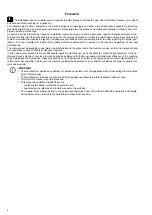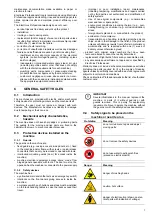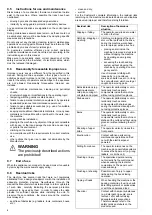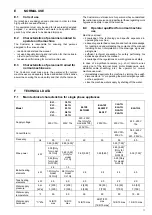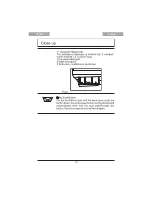
5
A.3
Personal protection equipment
Summary table of the Personal Protection Equipment (PPE) to be used during the various
stages of the machine's service life.
Stage
Protective
garments
Safety
footwear
Gloves
Glasses
Safety
helmet
Transport
—
●
○
—
○
Handling
●
●
○
—
—
Unpacking
○
●
○
—
—
Installation
○
●
●
1
—
—
Normal use
●
●
●
2
○
—
Adjustments
○
●
—
—
—
Routine
cleaning
○
●
●
ˉ
3
○
—
Extraordi-
nary
cleaning
○
●
●
ˉ
○
—
Maintenance
○
●
○
—
—
Dismantling
○
●
○
○
—
Scrapping
○
●
○
○
—
Key:
●
PPE REQUIRED
○
PPE AVAILABLE OR TO BE USED IF NECESSARY
—
PPE NOT REQUIRED
1. During these operations, gloves must be cut-resistant. Failure to use the personal protection equipment by
operators, specialized personnel or users can involve exposure to damage to health (depending on the
model).
2. During these operations, gloves must be heatproof and suitable for contact with water and the substances
used (refer to the safety data sheet of the substances used for the information regarding the required PPE).
Failure to use the personal protection equipment by operators, specialised personnel or users can involve
exposure to chemical risk and cause possible damage to health (depending on the model).
3. During these operations, gloves must be suitable for contact with chemical substances used (refer to the
safety data sheet of the substances used for information regarding the required PPE). Failure to use the
personal protection equipment by operators, specialized personnel or users can involve exposure to
chemical risk and cause possible damage to health (depending on the model).
A.4
Water connection
• The operating water pressure (minimum and maximum) must be between:
– 2 bar [200 kPa] and 3 bar [300 kPa] for appliances without rinse pump;
– 0.5 bar [50 kPa] and 7 bar [700 kPa] for appliances with rinse pump;
• Make sure that there are no visible water leaks during and after the first use of the
machine.
A.5
Electrical connection
• Work on the electrical systems must only be carried out by a specialised personnel.


